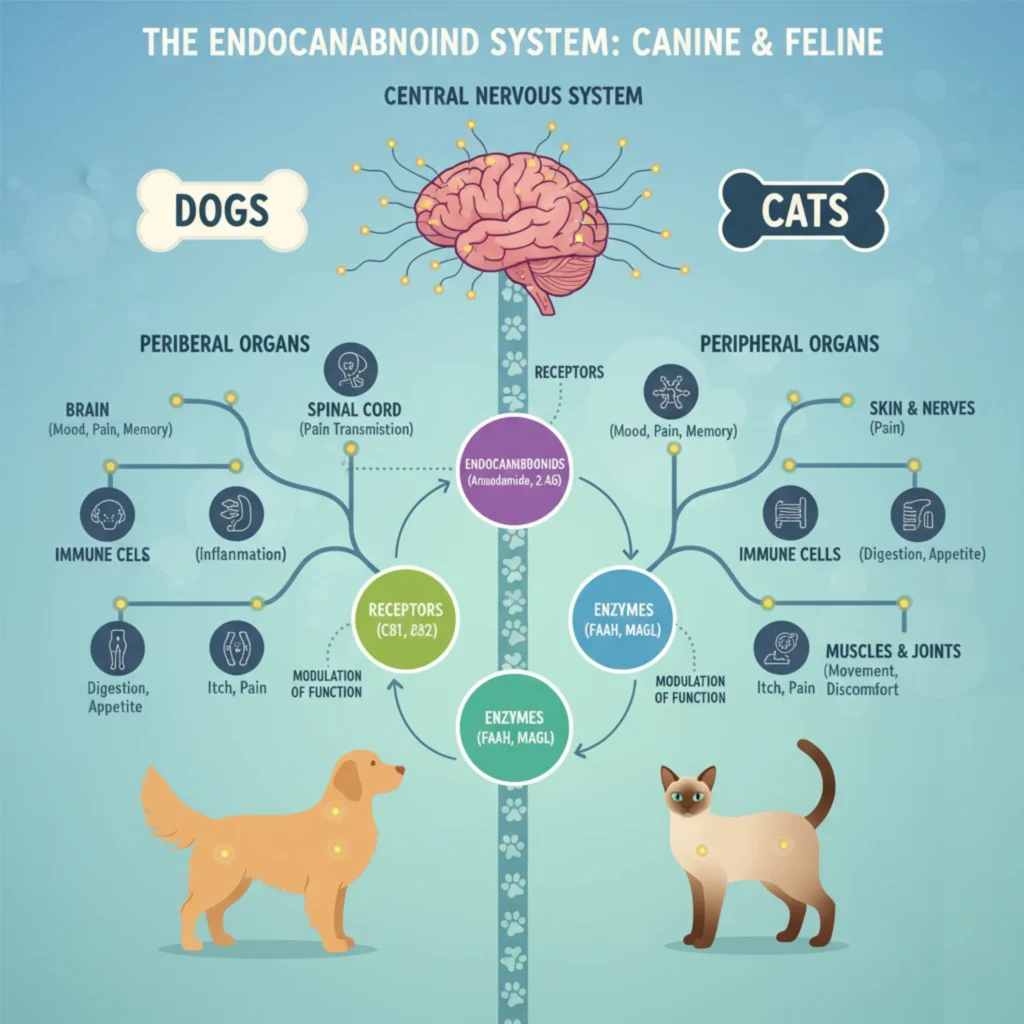
Unlocking Wellness: How CBD and the Endocannabinoid System Can Help Your Dog and Cat 🐾
As pet parents, we all want our furry companions to live their happiest, healthiest lives. When our dogs or cats start slowing down, showing signs of anxiety, or dealing with chronic discomfort, it’s natural to seek safe, effective ways to help. One area of growing interest is the use of Cannabidiol (CBD) to support pet wellness—and the science behind it lies in a system you may not have heard of: the Endocannabinoid System (ECS).
What is the Endocannabinoid System (ECS)?
The Endocannabinoid System is a complex cell-signaling network found in all mammals, including dogs, cats, and humans. Think of the ECS as your pet’s internal master regulator, constantly working to maintain homeostasis—a state of internal balance.
The ECS is made up of three main components:
Endocannabinoids: These are natural compounds your pet’s body produces on demand. They act as “messengers.” (Examples: Anandamide and 2-AG).
Receptors (CB1 and CB2): These are found throughout the body and act as “receivers.”
CB1 Receptors are mostly concentrated in the Central Nervous System (brain and spinal cord), influencing mood, memory, and movement. (Fun fact: Dogs have a higher concentration of CB1 receptors in their brains than humans, making them more sensitive to THC.)
CB2 Receptors are primarily found in the Peripheral Nervous System and Immune System, affecting inflammation and pain perception.
Enzymes: These proteins break down endocannabinoids after they’ve done their job.
The ECS influences a vast range of physiological processes, including:
Mood and Stress Response
Appetite and Digestion
Sleep
Immune Function and Inflammation
Pain Sensation
How Does CBD Interact with a Pet’s ECS?
CBD, or Cannabidiol, is a phytocannabinoid (a plant-derived compound) found in hemp. Unlike THC, which can cause a psychoactive “high” and is toxic to pets, CBD is non-psychoactive.
CBD doesn’t bind directly or strongly to the CB1 and CB2 receptors like THC does. Instead, it works indirectly to support the ECS in a couple of powerful ways:
Slowing the Breakdown: CBD can inhibit the enzymes responsible for breaking down your pet’s natural endocannabinoids. By allowing these natural “balancing messengers” to stay in the system longer, CBD helps enhance and prolong their beneficial effects, promoting a state of calm and balance.
Triggering Receptors: As a phytocannabinoid, CBD can also interact with other receptors throughout the body to initiate the ECS’s balancing processes.
Essentially, by supplementing and modulating the ECS, CBD helps your pet’s body do what it’s naturally designed to do: maintain optimal health and stability.
What Issues Can CBD Help Relieve in Dogs and Cats?
Because the ECS is so widespread, supporting it with CBD can potentially help alleviate a variety of common pet issues. While research is still emerging, studies and clinical experience suggest positive results in areas like:
Safety First: What to Know Before Giving Your Pet CBD
While CBD is generally considered safe and well-tolerated in dogs and cats, it’s crucial to take a cautious and informed approach.
Always Consult Your Veterinarian
Before starting any new supplement, speak with your veterinarian. This is essential, especially if your pet is already on medication, as CBD can affect liver enzymes that metabolize certain drugs. Your vet can provide personalized advice on dosage and product selection.
Choose a High-Quality, THC-Free Product
Dogs are highly sensitive to THC, the psychoactive compound in cannabis. Always choose hemp-derived CBD products with less than 0.3% THC (or, ideally, products clearly labeled as THC-free or broad-spectrum). Look for brands that provide:
Third-Party Lab Testing (Certificate of Analysis): This verifies the product’s CBD and THC content and confirms it’s free of contaminants like heavy metals and pesticides.
Clear Dosage Instructions: Start with the lowest recommended dose and monitor your pet’s response.
Watch for Side Effects
Reported side effects are typically mild and transient, but include:
Drowsiness/Lethargy
Mild Gastrointestinal upset (diarrhea or vomiting)
Dry mouth (increased thirst)
By understanding the Endocannabinoid System and how CBD interacts with it, you can make an informed decision about integrating this natural supplement into your cherished companion’s wellness routine. Here’s to happier, healthier pets!


